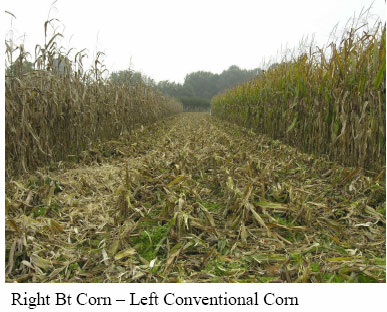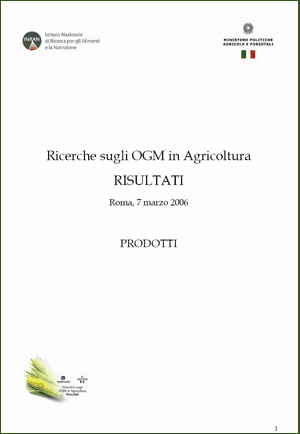Delft, The Netherlands, Milan, Italy and Tuskeege, Alabama
November 13, 2007
Source:
The Public Research &
Regulation Initiative (PRRI) and
AgBioView
According to the authors of the press
release, data from field trials conducted in Italy which
compared GM and non-GM maize have been suppressed for two
years by government officials and scientist at a public
research institution.
For a quick view see
summary
prepared by Klaus Ammann.
(PDF)
 Data from field trials conducted
in Italy which compared GM and non-GM maize have been suppressed
for two years by government officials and scientist at a public
research institution. The data, which are highly relevant to
public health, are striking and significant. Data from field trials conducted
in Italy which compared GM and non-GM maize have been suppressed
for two years by government officials and scientist at a public
research institution. The data, which are highly relevant to
public health, are striking and significant.
The trials were conducted in
Lombardy, a major maize-growing region in the northern part of
Italy, and compared two conventional maize varieties with two
similar varieties genetically engineered to produce the Bt
proteins which
protect the crop from European corn borers The two engineered Bt
maize varieties, P67 and Elgina, are similar to those grown
commercially on 20 million hectares in many countries, including
some member states of the European Community. They were planted
in 2005 in Landriano at a farm owned by the University of Milan
along with their nonengineered counterparts, P66 and Cecilia,
and comparing the grain yield data demonstrated spectacular
results.
The conventional varieties
produced between 11 and 11.1 tons of grain per hectare, while
the engineered varieties yielded between 14.1 and 15.9 tons per
hectare. This translates into a yield increase of between 28 and
43 percent. Italian farmers are not allowed to plant Bt maize.
Taking into account the total area of conventional maize
cultivation in Italy, the yield differences, maize prices and
pest pressures, the data show that Italian farmers have
forfeited between roughly 300 million and 1 billion Euros a year
because of the continuing prohibition.
These yield data were released in
2006 by the National Institute for Research on Food and
Nutrition (INRAN), a research institution funded and run by the
government, albeit without the emphasis they deserved. The data
were never formally published in a peer-reviewed scientific
journal and
the report page has been moved to secondary pages on
the INRAN server.
http://www.inran.it/inran/rapporti_con_il_mipaf/progetti_strategici/OGM%20in%20Agricoltura%20prodotti.pdf
Other data from those field trials,
however, have until now been kept
completely hidden. From the perspective of public health, they
are far more important.
The field trials in question were
actually designed to determine if GM crops could be useful to
Italian agriculture or pose dangers to consumers. The outcome
confirms that not only maize enhanced to resist insect pests can
be
more profitable for farmers but it also has a positive effect on
the quality of the grain, having a reduced fumonisin content.
Fumonisins are toxins produced by fungi which can infect a
growing maize plant. These toxins are dangerous to humans and
animals; in humans there is evidence that they cause spina
bifida, a highly disabling developmental defect occurring during
early stages of pregnancy. Affected children usually cannot walk
and they suffer kidney and urinary problems. Often, this is
accompanied by brain damage. In horses and pigs, fumonisins
cause other kind of illnesses.
The fungi infect a growing maize
plant by entering the plant through a wound. Since European corn
borers inflict significant wounds on growing corn plants, they
leave these plants open to infection. During the field trials in
Lombardy, no corn borer larvae were found on the engineered Bt
varieties. At the same time, an average of 29 of these pests
were found on each stalk of the conventional varieties--with
more than one-third of them in the cobs.
 It
is unfortunate that so little attention was paid to the
financial significance of the findings. It is another matter
entirely to cover up data with obvious implications for public
health, and it is up to the government to explain why the data
on these toxins were kept under wraps. It
is unfortunate that so little attention was paid to the
financial significance of the findings. It is another matter
entirely to cover up data with obvious implications for public
health, and it is up to the government to explain why the data
on these toxins were kept under wraps.
The data were generated in the
public sector with taxpayers' money, and they were produced by
the University of Milan, a
reputable public body. It is unquestionable that they belong to
the Italian public, and their relevance to human and animal
health is unequivocal.
The data should be submitted as
quickly as possible for publication in a reputable journal, so
that the scientific community is informed. It is immediately
crucial, however, that they be made widely available so that
consumers and farmers can clearly understand the financial and
medical issues at stake. This is made far more urgent because of
the misinformation and lies being spread by the 'Free from GMOs'
('Liberi da OGM') campaign, a large coalition of lobby groups
which are trying to impose a permanent ban on the cultivation of
GM crops in Italy.
Contacts
Piero Morandini
Department of Biology "L. Gorini"
University of Milan
Tel: +39-02-5031-4816
Roberto Defez
Istituto di Genetica e Biofisica "A. Buzzati Traverso", CNR
Tel: 0039 081 6132440 |